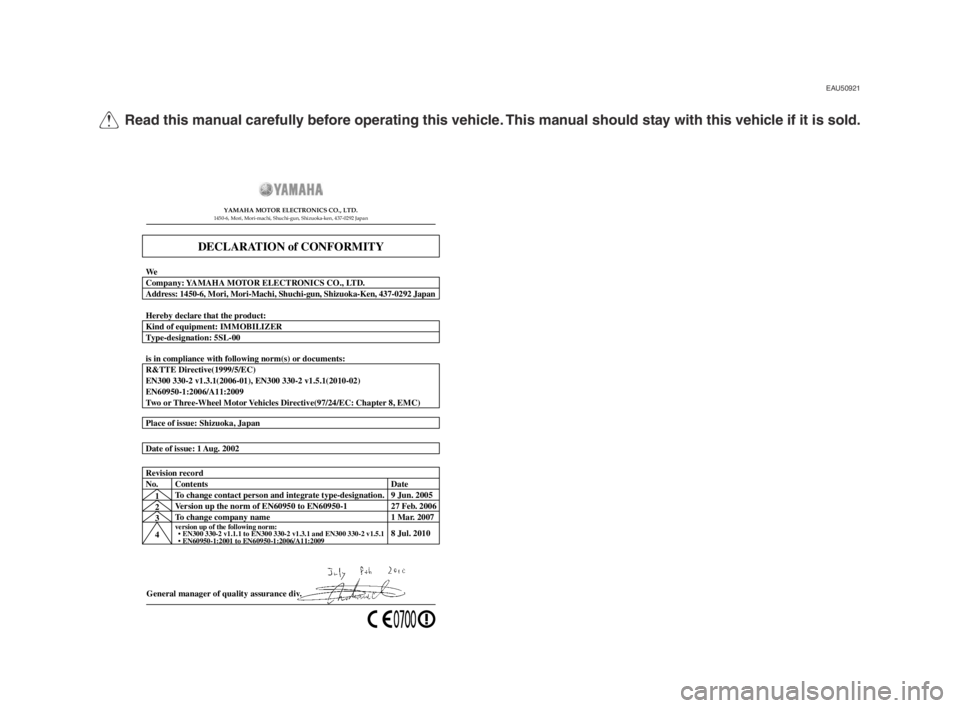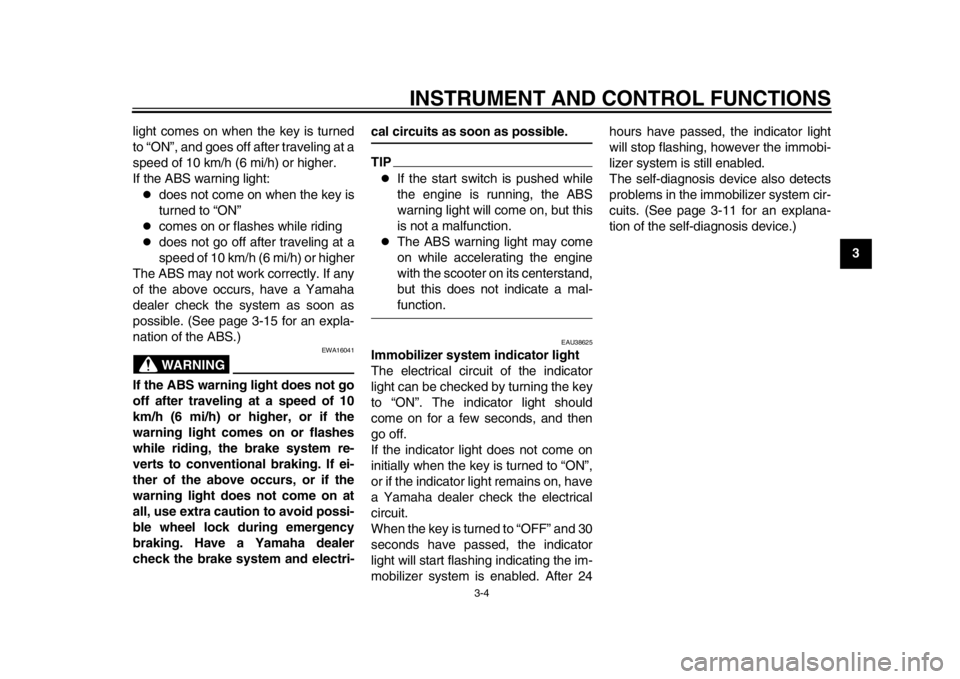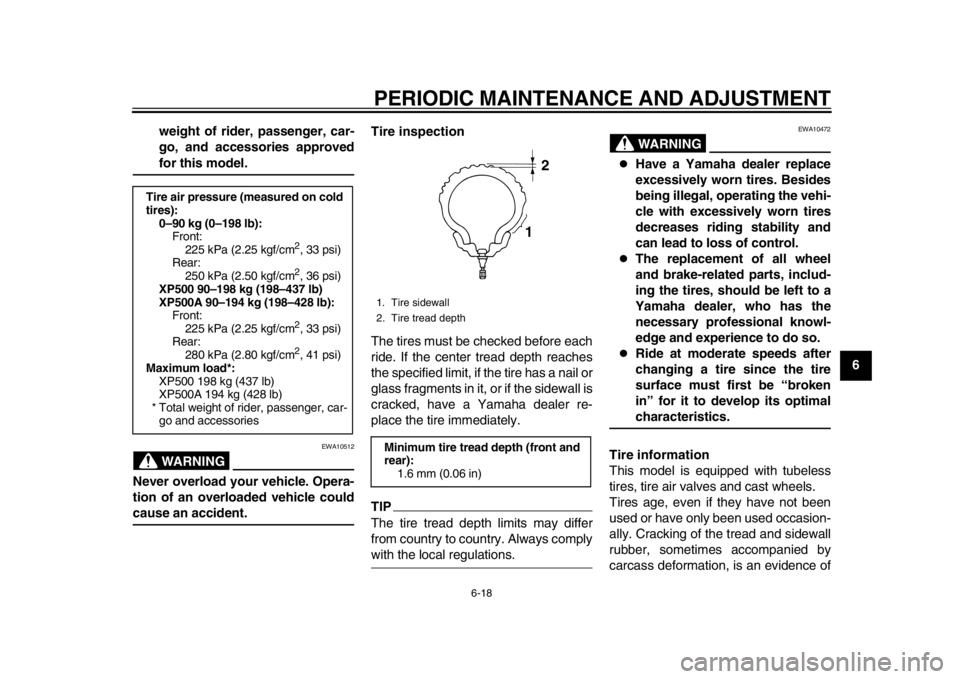wheel YAMAHA TMAX 2014 Owners Manual
[x] Cancel search | Manufacturer: YAMAHA, Model Year: 2014, Model line: TMAX, Model: YAMAHA TMAX 2014Pages: 100, PDF Size: 3.01 MB
Page 2 of 100

Q R\fad t\bis manual car\ffully b\ffor\f op\frating t\bis v\f\bicl\f. T\bis manual s\bould stay wit\b t\bis v\f\bicl\f if it is sold.
EAU50921
General manager of\d quality assurance\d di\f.
Date of issue: \b Aug. 2002 Place of issue: Shi\dzuoka, Japan
DECLARATION of CONFORMITY\d
YAMAHA MOTOR ELECT\
RONICS CO., LTD.1450-6, Mori, Mori-machi, Shuchi-gu\f, Shizuoka-ke\f, 4\b7-0292 Japa\f
Company: YAMAHA MOTOR ELECTRONICS CO., LTD.
We
Address: \b450-6, Mori, Mori-Machi, Shuchi-gun, Shizuoka-Ken, 437-0292 Japan
Kind of equipment: \dIMMOBILIZER Hereby declare that the product:
Type-designation: 5S\dL-00
is in compliance w\dith following norm(s) o\dr documents:
R&TTE Directi\fe(\b999/5/EC)
EN300 330-2 \f\b.3.\b(2\d006-0\b), EN300 330-\d2 \f\b.5.\b(20\b0-02)
EN60950-\b:2006/A\b\b:20\d09
Two or Three-Wheel Motor Vehicles Directi\fe(97/24/EC: Ch\dapter 8, EMC)
\b
2
3
4 Version up the norm\d of EN60950 to EN6\d0950-\b
To change company n\dame
\fersion up of the following norm:
EN300 330-2 \f\b.\b.\b\d to EN300 330-2 \f\b.\d3.\b and EN300 330-2\d \f\b.5.\b
EN60950-\b:200\b to \dEN60950-\b:2006/A\b\b:20\d09
27 Feb. 2006
\b Mar. 2007
8 Jul. 20\b0
Re\fision record
No. Contents
To change contact p\derson and integrate\d type-designation. Date
9 Jun. 2005
59C-9-E2_Hyoshi.indd 22013/07/03 14:36:46
Page 6 of 100

TABLE OF CONTENTSSAFETY INFORMATION................... 1-1
Further safe-riding points................. 1-5
DESCRIPTION ................................... 2-1
Left view .......................................... 2-1
Right view ........................................ 2-2
Controls and instrument s................. 2-3
INSTRUMENT AND CONTROL
FUNCTIONS ....................................... 3-1
Immobilizer system ....... ................... 3-1
Main switch/steering lock................. 3-2
Indicator lights and warning lights ............................................. 3-3
Speedometer ................................... 3-5
Tachometer ..................................... 3-5
Multi-function display ....................... 3-5
Handlebar switches ....................... 3-12
Front brake lever ........................... 3-13
Rear brake lever ............................ 3-14
Rear brake lock lever..................... 3-15
ABS (for ABS models) .. ................. 3-15
Fuel tank cap ................................. 3-16
Fuel................................................ 3-17
Catalytic converter ......................... 3-19
Seat ............................................... 3-19
Adjusting the rider backrest ........... 3-20
Helmet holder ................................ 3-21
Storage compartments .................. 3-21
Windshield ..................................... 3-23
Rear view mirrors .......................... 3-25 Shock absorber assembly ............. 3-25
Sidestand ...................................... 3-26
Ignition circuit cut-
off system ......... 3-26
FOR YOUR SAFETY –
PRE-OPERATION CHECKS ............. 4-1
OPERATION AND IMPORTANT
RIDING POINTS ................................. 5-1
Starting the engine .......................... 5-1
Starting off ....................................... 5-2
Acceleration and deceleration ......... 5-3
Braking ............................................ 5-3
Tips for reducing fuel
consumption ................................ 5-4
Engine break-in ............................... 5-4
Parking ............................................ 5-5
PERIODIC MAINTENANCE AND
ADJUSTMENT ................................... 6-1
Owner’s tool kit................................ 6-2
Periodic maintenance chart for the emission control system .............. 6-3
General maintenance and lubrication chart ........................... 6-4
Removing and installing panels ...... 6-8
Checking the spark plugs .............. 6-10
Engine oil and oil filter cartridge .... 6-11
Coolant .......................................... 6-14
Replacing the air filter element...... 6-15 Adjusting the engine idling
speed............ ............................ .. 6-16
Checking the throttle grip free play ............................................. 6-17
Valve clearance ............................. 6-17
Tires ............................................... 6-17
Cast wheels ................................... 6-19
Checking the front and rear brake
lever free play ............................. 6-20
Adjusting the rear brake lock cable ........................................... 6-21
Checking the rear brake lock ......... 6-21
Checking the front and rear brake pads............................................ 6-22
Checking the brake fluid level ........ 6-23
Changing the brake fluid ................ 6-24
Drive belt slack .............................. 6-24
Checking and lubricating the cables ......................................... 6-24
Checking and lubricating the
throttle grip and cable ................. 6-25
Lubricating the front and rear brake levers ................................ 6-25
Checking and lubricating the centerstand and sidestand ......... 6-26
Checking the front fork................... 6-26
Checking the steering .................... 6-27
Checking the wheel bearings......... 6-27
Battery ........................................... 6-28
Replacing the fuses ....................... 6-30
Replacing the headlight bulb ......... 6-3259C-9-E2.book 1 ページ 2013年6月18日 火曜日 午後1時33分
Page 9 of 100

1-2
1
SAFETY INFORMATION
tice riding your scooter where
there is no traffic until you have
become thoroughly familiar with
the scooter and all of its con-
trols.
Many accidents have been caused
by error of the scooter operator. A
typical error made by the operator
is veering wide on a turn due to ex-
cessive speed or undercornering
(insufficient lean angle for the
speed).
Always obey the speed limit andnever travel faster than warrant-
ed by road and traffic conditions.
Always signal before turning or changing lanes. Make sure that
other motorists can see you.
The posture of the operator and
passenger is important for proper
control.
The operator should keep bothhands on the handlebar and
both feet on the operator foot-
rests during operation to main-
tain control of the scooter.
The passenger should always hold onto the operator, the seat
strap or grab bar, if equipped, with both hands and keep both
feet on the passenger footrests.
Never carry a passenger unless
he or she can firmly place both
feet on the passenger footrests.
Never ride under the influence of
alcohol or other drugs.
This scooter is designed for
on-road use only. It is not suitable
for off-road use.
Protective Apparel
The majority of fatalities from scooter
accidents are the result of head inju-
ries. The use of a safety helmet is the
single most critical factor in the preven-
tion or reduction of head injuries.
Always wear an approved helmet.
Wear a face shield or goggles.
Wind in your unprotected eyes
could contribute to an impairment
of vision that could delay seeing a
hazard.
The use of a jacket, substantial
shoes, trousers, gloves, etc., is ef-
fective in preventing or reducing
abrasions or lacerations.
Never wear loose-fitting clothes,
otherwise they could catch on the control levers or wheels and cause
injury or an accident.
Always wear protective clothing
that covers your legs, ankles, and
feet. The engine or exhaust sys-
tem become very hot during or af-
ter operation and can cause burns.
A passenger should also observe
the above precautions.
Avoid Carbon Monoxide Poisoning
All engine exhaust contains carbon
monoxide, a deadly gas. Breathing car-
bon monoxide can cause headaches,
dizziness, drowsiness, nausea, confu-
sion, and eventually death.
Carbon Monoxide is a colorless, odor-
less, tasteless gas which may be pres-
ent even if you do not see or smell any
engine exhaust. Deadly levels of car-
bon monoxide can collect rapidly and
you can quickly be overcome and un-
able to save yourself. Also, deadly lev-
els of carbon monoxide can linger for
hours or days in enclosed or poorly
ventilated areas. If you experience any
symptoms of carbon monoxide poison-
ing, leave the area immediately, get
fresh air, and SEEK MEDICAL TREAT-
59C-9-E2.book 2 ページ 2013年6月18日 火曜日 午後1時33分
Page 11 of 100

1-4
1
SAFETY INFORMATION
Aftermarket Parts, Accessories,
and Modifications
While you may find aftermarket prod-
ucts similar in design and quality to
genuine Yamaha accessories, recog-
nize that some aftermarket accessories
or modifications are not suitable be-
cause of potential safety hazards to you
or others. Installing aftermarket prod-
ucts or having other modifications per-
formed to your vehicle that change any
of the vehicle’s design or operation
characteristics can put you and others
at greater risk of serious injury or death.
You are responsible for injuries related
to changes in the vehicle.
Keep the following guidelines in mind,
as well as those provided under “Load-
ing” when mounting accessories.
Never install accessories or carry
cargo that would impair the perfor-
mance of your scooter. Carefully
inspect the accessory before using
it to make sure that it does not in
any way reduce ground clearance
or cornering clearance, limit sus-
pension travel, steering travel or
control operation, or obscure lights
or reflectors. Accessories fitted to the handle-
bar or the front fork area can
create instability due to improper
weight distribution or aerody-
namic changes. If accessories
are added to the handlebar or
front fork area, they must be as
lightweight as possible and
should be kept to a minimum.
Bulky or large accessories may seriously affect the stability of
the scooter due to aerodynamic
effects. Wind may attempt to lift
the scooter, or the scooter may
become unstable in cross
winds. These accessories may
also cause instability when
passing or being passed by
large vehicles.
Certain accessories can dis- place the operator from his or
her normal riding position. This
improper position limits the free-
dom of movement of the opera-
tor and may limit control ability,
therefore, such accessories are
not recommended.
Use caution when adding electri-
cal accessories. If electrical acces- sories exceed the capacity of the
scooter’s electrical system, an
electric failure could result, which
could cause a dangerous loss of
lights or engine power.
Aftermarket Tires and Rims
The tires and rims that came with your
scooter were designed to match the
performance capabilities and to provide
the best combination of handling, brak-
ing, and comfort. Other tires, rims, siz-
es, and combinations may not be
appropriate. Refer to page 6-17 for tire
specifications and more information on
replacing your tires.
Transporting the Scooter
Be sure to observe following instruc-
tions before transporting the scooter in
another vehicle.
Remove all loose items from the
scooter.
Point the front wheel straight
ahead on the trailer or in the truck
bed, and choke it in a rail to pre-
vent movement.
Secure the scooter with tie-downs
or suitable straps that are attached
59C-9-E2.book 4 ページ 2013年6月18日 火曜日 午後1時33分
Page 19 of 100

INSTRUMENT AND CONTROL FUNCTIONS
3-4
234
5
6
7
8
9
light comes on when the key is turned
to “ON”, and goes off after traveling at a
speed of 10 km/h (6 mi/h) or higher.
If the ABS warning light:
does not come on when the key is
turned to “ON”
comes on or flashes while riding
does not go off after traveling at a
speed of 10 km/h (6 mi/h) or higher
The ABS may not work correctly. If any
of the above occurs, have a Yamaha
dealer check the system as soon as
possible. (See page 3-15 for an expla-
nation of the ABS.)WARNING
EWA16041
If the ABS warning light does not go
off after traveling at a speed of 10
km/h (6 mi/h) or higher, or if the
warning light comes on or flashes
while riding, the brake system re-
verts to conventional braking. If ei-
ther of the above occurs, or if the
warning light does not come on at
all, use extra caution to avoid possi-
ble wheel lock during emergency
braking. Have a Yamaha dealer
check the brake system and electri-
cal circuits as soon as possible.TIP
If the start switch is pushed while
the engine is running, the ABS
warning light will come on, but this
is not a malfunction.
The ABS warning light may come
on while accelerating the engine
with the scooter on its centerstand,
but this does not indicate a mal-function.
EAU38625
Immobilizer system indicator light
The electrical circuit of the indicator
light can be checked by turning the key
to “ON”. The indicator light should
come on for a few seconds, and then
go off.
If the indicator light does not come on
initially when the key is turned to “ON”,
or if the indicator light remains on, have
a Yamaha dealer check the electrical
circuit.
When the key is turned to “OFF” and 30
seconds have passed, the indicator
light will start flashing indicating the im-
mobilizer system is enabled. After 24 hours have passed, the indicator light
will stop flashing, however the immobi-
lizer system is still enabled.
The self-diagnosis device also detects
problems in the immobilizer system cir-
cuits. (See page 3-11 for an explana-
tion of the self-diagnosis device.)
59C-9-E2.book 4 ページ 2013年6月18日 火曜日 午後1時33分
Page 30 of 100

INSTRUMENT AND CONTROL FUNCTIONS
3-15
1
23
4
5
6
7
8
9
EAU12963
Rear brake lock leverThis vehicle is equipped with a rear
brake lock lever to prevent the rear
wheel from moving while stopped at
traffic signals, railroad crossings, etc.
To lock the rear wheel
Push the rear brake lock lever to the left
until it snaps into place.
To unlock the rear wheel
Push the rear brake lock lever back to
the original position.TIP
Be sure to check that the rear
wheel does not move when therear brake lock lever is applied.
To provide secure locking of the
rear wheel, apply the rear brake le-
ver first before moving the rearbrake lock lever to the left.WARNING
EWA12362
Never move the rear brake lock lever
to the left while the vehicle is mov-
ing, otherwise loss of control or an
accident may result. Make sure that
the vehicle is stopped before mov-
ing the rear brake lock lever to theleft.
EAU54001
ABS (for ABS models)The Yamaha ABS (Anti-lock Brake
System) features a dual electronic con-
trol system, which acts on the front and
rear brakes independently.
Operate the brakes with ABS as you
would conventional brakes. If the ABS
is activated, a pulsating sensation may
be felt at the brake levers. In this situa-
tion, continue to apply the brakes and
let the ABS work; do not “pump” the
brakes as this will reduce braking effec-
tiveness.
WARNING
EWA16051
Always keep a sufficient distance
from the vehicle ahead to match the
riding speed even with ABS.
The ABS performs best with
long braking distances.
On certain surfaces, such as
rough or gravel roads, the brak-
ing distance may be longer withthe ABS than without.
The ABS is monitored by an ECU,
which will revert the system to conven-
tional braking if a malfunction occurs.
1. Rear brake lock lever
1
59C-9-E2.book 15 ページ 2013年6月18日 火曜日 午後1時33分
Page 31 of 100

INSTRUMENT AND CONTROL FUNCTIONS
3-16
234
5
6
7
8
9
TIP
The ABS performs a self-diagno-
sis test each time the vehicle first
starts off after the key is turned to
“ON” and the vehicle has traveled
at a speed of 10 km/h (6 mi/h) or
higher. During this test, a “clicking”
noise can be heard from the front
of the vehicle, and if either brake
lever is even slightly applied, a vi-
bration can be felt at the lever, but
these do not indicate a malfunc-
tion.
This ABS has a test mode which
allows the owner to experience the
pulsation at the brake levers when
the ABS is operating. However,
special tools are required, so
please consult your Yamaha deal-er when performing this test.
NOTICE
ECA16121
Keep any type of magnets (including
magnetic pick-up tools, magnetic
screwdrivers, etc.) away from the
front and rear wheel hubs, otherwise
the magnetic rotors equipped in the
wheel hubs may be damaged, result- ing in improper performance of the
ABS system.
EAU13176
Fuel tank capTo remove the fuel tank cap
1. Open the lid by pulling the lever up.
2. Insert the key into the lock and turn it clockwise. The lock will be re-
leased and the fuel tank cap can
be removed.
1. Front wheel hub
1. Rear wheel hub
11
1. Opening lever
2. Lid
1
2
59C-9-E2.book 16 ページ 2013年6月18日 火曜日 午後1時33分
Page 44 of 100

FOR YOUR SAFETY – PRE-OPERATION CHECKS
4-2
1
2
34
5
6
7
8
9
Rear brake Check operation.
If soft or spongy, have Yamaha dealer bleed hydraulic system.
Check brake pads for wear.
Replace if necessary.
Check fluid level in reservoir.
If necessary, add specified brake fluid to specified level.
Check hydraulic system for leakage. 6-20, 6-22, 6-23
Throttle grip Make sure that operation is smooth.
Check throttle grip free play.
If necessary, have Yamaha dealer adjust throttle grip free play and lubricate cable
and grip housing. 6-17, 6-25
Wheels and tires Check for damage.
Check tire condition and tread depth.
Check air pressure.
Correct if necessary. 6-17, 6-19
Brake levers Make sure that operation is smooth.
Lubricate lever pivoting points if necessary. 6-25
Centerstand, sidestand Make sure that operation is smooth.
Lubricate pivots if necessary. 6-26
Chassis fasteners Make sure that all nuts, bolts
and screws are properly tightened.
Tighten if necessary. —
Instruments, lights, signals
and switches Check operation.
Correct if necessary.
—
Sidestand switch Check operation of ignition circuit cut-off system.
If system is not working correctly, have Yamaha dealer check vehicle. 3-26
ITEM CHECKS PAGE
59C-9-E2.book 2 ページ 2013年6月18日 火曜日 午後1時33分
Page 53 of 100

PERIODIC MAINTENANCE AND ADJUSTMENT
6-4
2
3
4
567
8
9
EAU1770G
General maintenance and lubrication chartNO. ITEM CHECK OR MAINTENANCE JOB ODOMETER READING
ANNUAL
CHECK
1000 km
(600 mi) 10000 km
(6000 mi) 20000 km
(12000 mi) 30000 km
(18000 mi) 40000 km
(24000 mi)
1 Air filter element Replace.
2 *V-belt case air filter
elements Clean.
Replace.
3 *Front brake Check operation, fluid level and
vehicle for fluid leakage.
Replace brake pads. Whenever worn to the limit
4 *Rear brake Check operation, fluid level and
vehicle for fluid leakage.
Replace brake pads. Whenever worn to the limit
5 *Brake hoses Check for cracks or damage.
Check for correct routing and
clamping.
Replace. Every 4 years
6 *Brake fluid Replace. Every 2 years
7 Rear brake lock
cable Check cable length.
Adjust if necessary.
4000 km (2400 mi) after the initial 1000 km (600 mi) and every
5000 km (3000 mi) thereafter
8 *Rear brake lock Check operation.
Check rubber boot.
Check wear indicator.
Adjust if necessary.
9 *Wheels Check runout and for damage.
10 *Tires Check tread depth and for
damage.
Replace if necessary.
Check air pressure.
Correct if necessary.
11 *Wheel bearings Check bearing for looseness or
damage.
59C-9-E2.book 4 ページ 2013年6月18日 火曜日 午後1時33分
Page 67 of 100

PERIODIC MAINTENANCE AND ADJUSTMENT
6-18
2
3
4
567
8
9
weight of rider, passenger, car-
go, and accessories approved
for this model.WARNING
EWA10512
Never overload your vehicle. Opera-
tion of an overloaded vehicle couldcause an accident. Tire inspection
The tires must be checked before each
ride. If the center tread depth reaches
the specified limit, if the tire has a nail or
glass fragments in it, or if the sidewall is
cracked, have a Yamaha dealer re-
place the tire immediately.
TIPThe tire tread depth limits may differ
from country to country. Always complywith the local regulations.
WARNING
EWA10472
Have a Yamaha dealer replace
excessively worn tires. Besides
being illegal, operating the vehi-
cle with excessively worn tires
decreases riding stability and
can lead to loss of control.
The replacement of all wheel
and brake-related parts, includ-
ing the tires, should be left to a
Yamaha dealer, who has the
necessary professional knowl-
edge and experience to do so.
Ride at moderate speeds after
changing a tire since the tire
surface must first be “broken
in” for it to develop its optimalcharacteristics.
Tire information
This model is equipped with tubeless
tires, tire air valves and cast wheels.
Tires age, even if they have not been
used or have only been used occasion-
ally. Cracking of the tread and sidewall
rubber, sometimes accompanied by
carcass deformation, is an evidence of
Tire air pressure (measured on cold
tires): 0–90 kg (0–198 lb): Front:225 kPa (2.25 kgf/cm
2, 33 psi)
Rear: 250 kPa (2.50 kgf/cm2, 36 psi)
XP500 90–198 kg (198–437 lb)
XP500A 90–194 kg (198–428 lb):
Front:225 kPa (2.25 kgf/cm2, 33 psi)
Rear: 280 kPa (2.80 kgf/cm2, 41 psi)
Maximum load*:
XP500 198 kg (437 lb)
XP500A 194 kg (428 lb)
* Total weight of rider, passenger, car-
go and accessories
1. Tire sidewall
2. Tire tread depthMinimum tire tread depth (front and
rear): 1.6 mm (0.06 in)
1 2
59C-9-E2.book 18 ページ 2013年6月18日 火曜日 午後1時33分